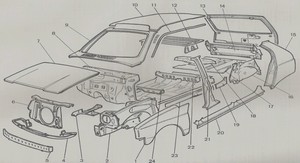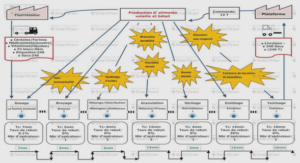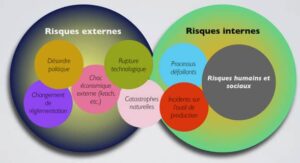Tendon force distribution
A key characteristic of tendon-driven systems is the necessity of maintaining positive tendon forces. Indeed, the model is invalid if the tendon tension falls to zero. In such a case, the system does not any longer comply with the equations of motion and may become uncontrollable1 . Depending on the mechanical design, it might even get damaged. In the Awiwi Hand , the antagonistic configuration and the use of nonlinear springs2 allows to adjust the joint stiffness by modifying the pretension of the tendons. Therefore, the question arises: How should one select the tendon forces to generate the desired joint torque in real time and realize the desired mechanical stiffness while preventing slackening or overload of the tendons? In the modeling part, it has been shown that the joint torque can be obtained from the tendon forces and the coupling matrix. Therefore, an algorithm that inverses the mapping is needed. However, neither a pseudo-inversion of the coupling matrix nor a projection can guarantee that the desired tendon forces will be restricted to a given range. In the following chapter, the objective is to build an algorithm to set the pretension forces to approximate the userrequired mechanical stiffness. Because of the constraints, this is not possible in general and only an approximative solution can be found. First, a formal description of the problem is given. The second section presents several solutions to the problem and discusses the advantages and drawbacks of each method. A pseudo-code that corresponds to the current implementation is reported.
Solutions
The problem (7.3) might not accept any solution because of the force range limits. A simple saturation of the solutions to the feasible tendon forces does not ensure that the joint torque is achieved, thus possibly destabilizing the system (the stability proofs are usually not including the nonlinear effects of the force saturation). The desired joint torque must be achieved as closely as possible, possibly even increasing the stiffness error. In order to circumvent this issue the problem is transformed into a quadratic optimization problem under linear constraints. minft (kKq,des − Kqk) τ des = P T ft with ft ∈ [ft,min, ft,max] m , (7.4) where the desired (resp. achieved) joint stiffness matrix is denoted Kq,des ∈ R n×n (resp. Kq ∈ R n×n ). The norm is the L2 norm. Because the problem is nonlinear (loosely said: kt(αft) 6= αkt(ft)), it is not possible to separate the selection of the internal tendon forces and the tendon forces that generate a link torque. The non-superposability distinguishes the problem from most of the cases discussed in the literature [53,124]. The transformation that maps the tendon forces in the joint torques and derives the joint stiffness is not bijective in general (but is certainly injective from [ft,min, ft,max] m to R n × R n×n ). Thus, for a given choice of joint stiffness matrix and torque, no exact solution exists. Moreover, as presented in the tendon modeling chapter, the tendon characteristics are approximated by polynomials or lookup tables. Therefore, it is not possible to explicitly find the inverse function Ψ−1 that maps the desired joint torques and stiffness to the tendon forces. It should be noted that the inversion can be reduced to a simple matrix inversion and allows an easier analysis if a suitable tendon stiffness model can be used [54]. A first possible approach to this problem is to perform a nonlinear optimization with constraints defined as, min ft (β1 kKq − Kq,desk + β2 kτ − τ desk) ft ∈ [ft,min . . . ft,max] m , (7.5) where (β1, β2) ∈ R 2 are weights to be selected depending on the desired behavior. Unfortunately, this optimization does not ensure that the desired torques are achieved. The stiffness can potentially lead to an incorrect torque and destabilize the system. Due to this stability issue, the torque is more important than the mechanical stiffness. A constraint can be added in the problem to solve the issue, min ft (β1 kKq − Kq,desk) ft ∈ [ft,min . . . ft,max] m P ft = τ des , (7.6) where β1 ∈ R n×n is a weight matrix to be selected depending on the relative importance of the joints. This latter formulation revealed to be complex to implement efficiently on the real-time machine, mainly due to the constraints. As a results the solver is not suitable for a real-time use. A reformulation of the problem (inspired by [18]) ensures that the desired torques are achieved if it is possible given the limits of the tendon forces. The problem is given by min α γ1kKq,des − Kqk + γ2Ψ(ft , ft,min) + γ3Ψ(ft , ft,max) , (7.7) where ft = (P T ) +τ des+ker (P T )α. The desired joint stiffness matrix (resp. the achieved joint stiffness matrix) is Kq,des ∈ R n×n (resp. Kq ∈ R n×n ). The tendon force limits are (ft,min, ft,max) ∈ R 2 . The term ker (P T )α operates in the null space of the coupling, and therefore, it does not generate any joint torque. The weighting factors γ1, γ2, and γ3 are used to balance the relative importance of the boundary potentials and the error. The boundary function Ψ implements a repulsive potential to repel the solution from the tendon force limits. It is important to note that, in contrast to (7.6) where the search is performed on ft ∈ R m, in (7.6) the search is performed only on α ∈ R n . This reduction of the search space provides a valuable run-time speed-up. Using this formulation, the particular shape of the nullspace of 115 the coupling matrix is used advantageously to improve the search speed. The pseudo-code corresponding to the search is reported in Alg. 2. The key feature of the algorithm is to ensure that the desired torque is exactly achieved. Although it does not strictly enforce that the force constraints are satisfied, they are in practice achieved since the boundary gains, i. e. γ2 and γ3, can be large to prevent the search from exceeding the limits. In particular, this algorithm is extremely efficient with constant coupling matrices (i. e. all fingers but the thumb of the hand of Awiwi Hand ). Indeed, if P is constant, a base W of the kernel of P T can be computed offline. In case of a position-varying coupling matrix, this algorithm needs to compute a singular value decomposition (or a pseudo-inverse) online thus severely impairing its execution time. Nonetheless, in the case of the thumb, despite its position dependance, the special shape of the coupling matrix (block diagonal) allows efficient implementation techniques.
Discussion
In this chapter, the problem of selecting the internal tendon forces has been described. Since the tendon forces modify the joint stiffness, it is not possible to independently set the stiffness and the torque. Several formulations of the problem are proposed and discussed. Unless assumptions are made on the stiffness function of the tendons, numerical search algorithms are the only available tool to optimally select the tendon forces. Although, initially, the search problem is of dimension equal to the number of tendons, it is possible to restrict the search to a base of the kernel of the coupling matrix. It ensures that the search algorithm satisfies the desired torque and reduces the dimension of the problem. Experimental results have been presented in [41]. Norms In this chapter, the notion of norm is required to define the optimization goals/costs. For real vectors, the norm operation from R n to R defined by (7.8) will be used unless otherwise specified. kxk = vuutXn i=0 x 2 i (7.8) where x ∈ R n is a real vector of dimension n ∈ N. i ∈ [1 . . . n] is a generic summation symbol. For real matrices, the definition is less natural and multiple norms have been proposed (max norm, entrywise norm, Schatten norm, Frobenius norm, [125]). In this chapter, either the norm defined by (7.9) or by (7.10) will be used. kAk = vuutXn i=0 a 2 i (7.9) 116 or kAk = max ai,j (7.10) where A ∈ R n×n is a real square matrix of dimension n ∈ N. (i, j) ∈ [1 . . . n] 2 are a generic summation symbols. In most cases, the norms can easily be changed since they are not needed to establish the properties.



